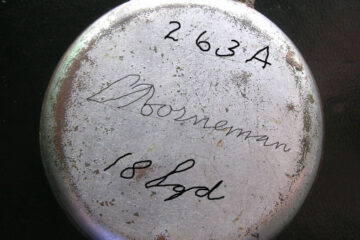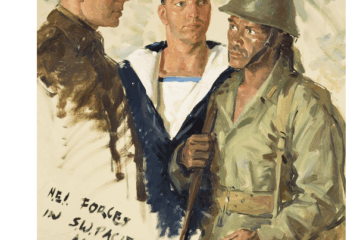Following the Japanese invasion and collapse of the Netherlands East Indies (NEI) in early 1942, Dutch political and military leadership scattered across the globe. Many civil and military authorities regrouped in Australia and Ceylon, while the central government-in-exile remained in London. Amid the chaos, a major political fault line emerged between those seeking to restore Dutch colonial control over the Indies and those advocating for political reform and greater autonomy for Indonesians after the war.
At the heart of this divide were two high-ranking colonial officials born in the Indies: Hubertus van Mook and Charles van der Plas. Their personal identification with the region, shared by many long-settled Dutch-Indonesian families (Indos), gave them a different perspective from their European counterparts. Both men believed that the postwar order could not simply return to the pre-war colonial status quo. Van Mook, appointed Lieutenant Governor-General in exile, began advocating for a federal model that would allow Indonesians a role in governance.
Van Mook’s ideas were not new. Before the war, he and Van der Plas had been involved with the Stuw group, a progressive forum that promoted reformist thinking about Dutch colonialism. When they arrived in Australia, they found a growing openness to postcolonial ideas. In his early discussions with Australian and American officials, Van Mook suggested that Indonesia would need a new political framework—one that granted meaningful self-governance and eventually, shared sovereignty with the Netherlands.
This vision sharply contrasted with that of the Dutch government-in-exile in London, led by Prime Minister Pieter Sjoerds Gerbrandy. Gerbrandy and his ministers viewed Van Mook’s initiatives as dangerous and ideologically subversive. In Ford’s account, Gerbrandy described Van Mook’s ideas as “a cardinal threat to the existence of the [Netherlands] nation” and saw the Indies reformers as having “practically gone native.” Their vision for a postwar Dutch–Indonesian partnership was seen by the London cabinet as weakening imperial unity and encouraging nationalist unrest.
The immediate result of this ideological rift was Van Mook’s recall to London in March 1942. Although nominally promoted to Minister for the Colonies, he was stripped of executive control and kept away from the centre of military planning. Gerbrandy’s instructions were clear: Van Mook was to “ensure the Indies maintains its imperial links and never stands on its own”. Van der Plas, who had been praised by many Australians for his cultural understanding and fluency in Malay and Arabic, was similarly recalled under pressure from conservative forces in London.
Yet even from exile, Van Mook continued to shape policy. He managed to reappoint Van der Plas to head the NEI Commission in Australia, and he expanded the Commission’s powers to include oversight of civil affairs, repatriation planning, and engagement with Allied officials. This shift drew new criticism from London, but it also laid the groundwork for what Van Mook hoped would become a future federal Indonesian system.
In 1944–45, as the tide of war shifted in favour of the Allies, Van Mook revived his autonomy proposals. He planned to convene a conference with Indonesian representatives in preparation for postwar governance. Gerbrandy strongly opposed the idea, fearing that it would legitimise nationalist claims and weaken Dutch sovereignty. According to Ford, Gerbrandy’s cabinet pressured Queen Wilhelmina not to endorse Van Mook’s initiative—but the Queen, perhaps recognising changing global tides, ultimately offered her qualified support.
Australia and the United States, for their part, became increasingly sympathetic to Van Mook’s position. Australia had taken in thousands of Dutch refugees, including Indos and Indonesians who had suffered under Japanese occupation. As the Curtin government began to reimagine its regional role, it viewed Van Mook’s proposed reforms as more realistic than a full restoration of colonial authority. Australian diplomats quietly encouraged Dutch openness to Indonesian voices, while Allied observers worried that Dutch rigidity might provoke postwar instability.
Van Mook’s proposals were ultimately overtaken by events. In August 1945, just days after Japan’s surrender, Indonesian nationalist leaders Sukarno and Hatta declared independence. Van Mook, now back in Australia and later Jakarta, would spend the next several years trying to negotiate a federal solution. But the wartime divisions within the Dutch administration had already fractured its moral and political credibility.
The wartime rift between the London-based government and the Indies-born reformers reveals how the Dutch empire was already fracturing from within well before Indonesia’s formal declaration of independence. Van Mook’s reform efforts—while ultimately unsuccessful—represented a meaningful attempt to modernise colonial governance in line with shifting global norms around sovereignty and self-determination.
This article is part of a six-part series on Dutch–Australian wartime cooperation. For related perspectives, see:
- Between secrecy and survival: Australia’s frustration with Dutch neutrality on the eve of war.
- Divided in exile: tensions between Batavia and London in the Dutch war effort.
- Wartime reform and Indonesian voices: Dutch–Indonesian political tensions in exile.
- The Dutch purchasing mission and wartime supply issues in Australia.
- From indifference to diplomacy: how the war transformed Dutch–Australian foreign relations
- A Dutch military and civil inventory in Australia – March 1942 snapshot
References: Jack Ford, Allies in a Bind: Australia and the Netherlands East Indies in the Second World War, CQU Press, 2001
R. W. A. van den Berg, Unchained Interests, Netherlands Staff College Monograph, 2021


